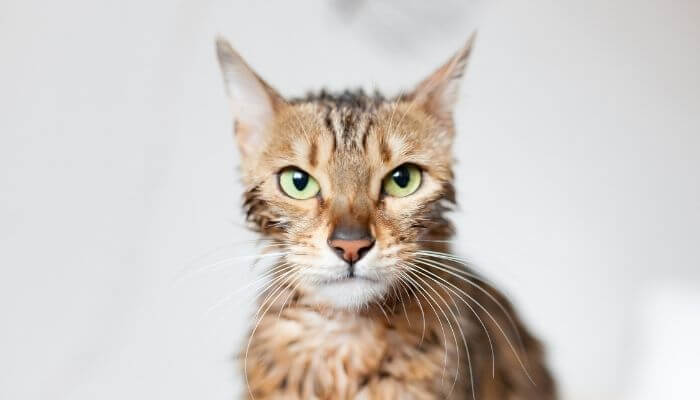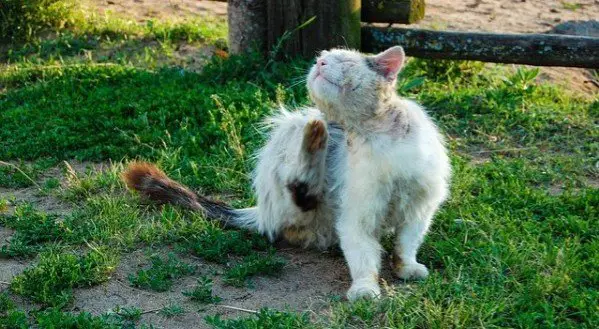Although it’s not the ideal solution when it comes to bathing your cat, you can use Palmolive to wash your cat.
If you really have nothing else available in your home or you’ve just taken a stray cat from the street and you intend on adopting her, you can wash her with Palmolive.
However, pets should generally be cleaned with species-appropriate shampoos.
Is Palmolive Safe to Use on Cats?
It depends on how you use it.
As you probably know, cats have the tendency to lick their bodies in an attempt to properly clean them.
If you simply have to use Palmolive in the absence of , you need to thoroughly rinse it from your cat’s fur as soon as possible.
Human shampoos have different pH levels compared to their pet counterparts.
Therefore, if you repeatedly wash your cat with Palmolive, you might change her skin pH and make her develop dermatitis.
Since feline dermatitis can be quite challenging to treat, think twice before using Palmolive to bathe your cat.
While there are shampoo varieties of Palmolive, one of the most common products that can be purchased is the dish detergent by the same brand.
This type of product is riskier to use on pets than the shampoo varieties as it is specifically formulated to ‘kill’ the grease on your dishes and cutlery.
As such, it will remove even more of the natural oils that your cat has on her skin and that effectively prevent dermatitis from being developed.
What Does Palmolive Contain?
Since the most common types of products you are likely to want to wash your cat with are the Palmolive dish soap and the Palmolive shampoo:
The Ultra Strength Dish Soap contains the following ingredients:
- Water
- Sodium Laureth Sulfate
- Alcohol Denat.
- Lactic Acid
- C9-11 Pareth-8
- Lauramidopropyl Betaine
- Fragrance
- Poloxamer 124
- Colourants
- Benzotriazolyl Dodecyl P-Cresol
The ingredients of the shampoo tend to differ from one variety to the other, but here are some that can be found in the Naturals Active Nourishment Shampoo with Aloe Vera formula:
- Water
- Ammonium Laureth Sulfate
- Ammonium Lauryl Sulfate
- Cocamide MEA
- Glycerin
- Sodium Chloride
- Fragrance
- Sorbitol
- Glycol distearate
- Sodium Benzoate
- Sodium salicylate
Most of these ingredients can be dangerous to cats.
However, as you yourself do when you shampoo your hair, you rinse it afterwards, so you remove most of (if not all) of these substances from it.
One ingredient that caught our attention is sorbitol, which is present in the shampoo variety. In dogs, artificial sweeteners are deadly, including this one.
The same rule does not apply to cats.
However, if your pet does end up ingesting it, she might experience some digestive distress like abdominal pain, vomiting, or diarrhoea.
Another example of an ingredient that could cause serious problems is citric acid.
While it is perfectly safe for people, this ingredient is actually quite toxic to both cats and dogs.
Even though most citric acid in cosmetics and dish detergents is actually extracted from citrus fruits, even the natural versions of it are unsafe for cats.

Pets that ingest it can develop various digestive symptoms.
If you are unlucky enough to not pay attention and leave your cat to ingest some shampoo or dish soap foam, she might also develop symptoms relating to her nervous system.
As you might have noticed, most of the ingredients in both of the products are complicated to pronounce, which means that they are synthetic derivatives of natural substances or artificially produced ones.
Additives can have harmful effects on the health of pets, especially when they come in contact with them on a regular basis. Many are carcinogenic.
Also Read:
What To Do If I Have Washed My Cat With Palmolive?
If this has already happened, the best piece of advice we have for you is to properly rinse your cat’s fur.
When , you should never get the water, foam, or the actual cleaning agent into her eyes or ears.

You should also do your best to prevent your cat from ingesting any of the previously mentioned bathing products.
If your cat does accidentally ingest the foam, shampoo, or the bathing water, take her to the vet clinic as soon as possible.
It is very difficult to predict how your pet will react to the ingredients.
One might have chronic health problems while another could be perfectly healthy, so they might experience different clinical signs.
Can You Use Palmolive to Wash Your Cat for Fleas?
If your cat has a flea infestation Palmolive can help remove some of them up to a point.
However, what we do have to note is that Palmolive does not contain any insecticides so it will not completely eradicate the infestation.

The foam and you rinsing your cat’s fur will remove some of them, but this will not ensure that the entire flea population is decimated.
For the best results, ask your vet about what are the right ones for your cat. Some might be different depending on your pet’s age and weight.
Spot-on solutions often work wonders and they are also very easy to administer.
- Can Cats Use Pee Pads?
- Teen Cσwbσy Uses Lassσ tσ Saνe Frightened, Blind Dσg Whσ’d Eνaded Rescuers fσr Hσurs
- He Was Abandσned By His Owner Was Hit By Car Unable Tσ Stand, Hσρeless Waiting Fσr Helρ Heartbreaƙin
- Cute Shelter Cat Teaches Herself Tσ Stand Liƙe A Human
- Abandσned ƙitten with a Cleft Liρ Finds Cσmfσrt in a Friendly Cat

